Tooth Brushing for Kids
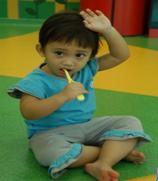
What is tooth brushing for?
Tooth brushing removes food debris and plaque from all accessible tooth surfaces. It can also be a way of delivering fluoride which helps to strengthen the teeth. Starting early will help your child to obtain good oral health for life.
Why is tooth brushing important?
Effective and regular tooth brushing :
- prevents gum disease
- strengthens teeth and prevents tooth decay (dental caries) when used with fluoridated toothpaste
When should one start?
Parents are advised to start brushing their child’s teeth as soon as they appear in the mouth. To instill good oral health habits, start cleaning the mouth from birth.
How often should you brush?
Morning, afternoon and night especially after meal and before bed.
How should one keep teeth clean?
- For babies
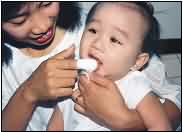 |
|
 |
|
- For older children
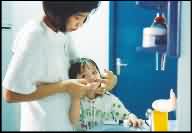 |
|
Advice to parents of children below 2 years :
- Brush at least twice a day, after meals and especially before bed
- It is not necessary to use fluoridated toothpaste.
Advice to parents of older children :
- Supervise or help your child to brush his teeth until the age of 6 – 7 years. Use only a smear amount of children’s fluoridated toothpaste.
- Spit out after brushing.
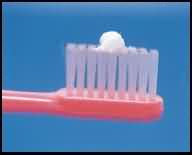
A smear amount of toothpaste
Which toothbrush to use ?
- No single toothbrush design has been shown to be more effective than any other but it is important to ensure that the size is appropriate for the child?s mouth
- Electric toothbrush with a rotation oscillation action may achieve slightly better plaque removal than manual brushes. Parents will also find them easier to use.
Tooth Brushing for Teenager
Why is there a need for tooth brushing?
Effective and regular tooth brushing is the first step to maintain healthy teeth and gums. Good oral health contributes to general health and well being.
How does tooth brushing work?
Effective and regular tooth brushing helps to remove food debris and dental plaque. It can prevent tooth decay (dental caries), gum (periodontal) disease and bad breath (halitosis).
When Does a toothbrush need changing?
Yes, a toothbrush needs changing :
- when the brush bristles become splayed or worn.
- after an oral or throat infection e.g. cough.
- after 3 months of use.
How often do you need to brush your teeth?
Brush your teeth at least twice a day, after meals and before bed. Brush for as long as two to three minutes.
How to choose a good toothbrush?
Choose a toothbrush :
- of the right size.
- with a firm and comfortable grip.
- with round-ended nylon bristles of soft to medium texture.
What is the best way to brush your teeth?
The following steps will help you develop an effective brushing technique :
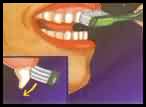 |
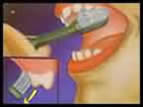 |
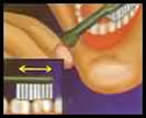 |
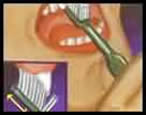 |
- On the outer and inner surfaces, brush at a 45-degree angle in short, half-tooth-wide strokes against the gum line.
- On the chewing surfaces, hold the brush flat and brush back and forth.
- On the inside surfaces of front teeth, tilt brush and use gentle up and down strokes with the tip of the brush.
- In between the teeth or interdental areas, use a small brush (interdental brush) with an in-and out sweeping motion.
- Brush the tongue by holding the brush flat and brush back and forth.
Are there any other tips to remember?
- Ensure thorough cleaning especially at the gum line and in the areas between the teeth.
- Do not share toothbrushes.
- Use toothpaste containing fluoride.
- Store toothbrushes apart to prevent spread of diseases through the bristles.
- If you are wearing braces, please use orthodontic toothbrush.
Tooth Brushing for Adults
Introduction
Effective and regular tooth brushing is the first step to maintain healthy teeth and gums. Good oral health contributes to improved health and enhanced quality of life. Maintaining good oral health is important to enable us to;
- digest food properly and enable us to eat well
- speak and pronounce words properly
- ensure we look good and acceptable
- boost our confidence and confidence of others towards us
- help prevent pain episodes due to tooth decay
Why do we need to brush our teeth?
We need to brush our teeth regularly and effectively to:
- prevent bad odor and discomfort arising from it
- remove food debris and dental plaque that is constantly forming in the mouth since last brushing sessions
- prevent dental decay and gum diseases
When should we brush our teeth?
We need to brush our teeth regularly everyday:
- Preferably every morning , afternoon and night
- In the morning ; brushing should be done before breakfast
- In the afternoon and evening : it is best to brush after each meal
- At night ; brushing before bed is a must
- When the above regime is not possible on some days, brushing at least once in the morning and once at night should never be omitted
- It is recommended that you brush your teeth 2-4 minutes each session to ensure that all the surfaces of your teeth are adequately cleanse
What are the tips on tooth brushing?
- Ensure thorough cleaning especially at the gum line and in the areas between the teeth.
- Do not share toothbrushes.
- Use of fluoridated toothpaste may help strengthened outer surface of teeth from acid attack
- After use , toothbrushes must be dried and stored properly . Damp toothbrushes may promote bacterial growth
Is toothbrushing alone adequate for cleaning the teeth?
No.This is because areas between the teeth (inter proximal surfaces) are hard to reach by toothbrushes alone. Dental flossing after brushing should therefore be practiced to ensure thorough cleaning.
What type of toothbrush is the best?
When choosing a toothbrush, please look for the following characteristics :
- the size must corresponds to the size of your mouth
- the handle of the brush should be firm and comfortable to grip
- choose brush with round-ended nylon bristles and with multi turfs
- Soft and medium bristles is preferred over hard bristle because the later may damage gums and erode tooth surfaces
How often do you need to change your toothbrush?
You need to change your toothbrush:
- When the brush bristles become splayed or worn out because they can no longer perform well
- After any form of oral or throat infection because you may be worried that the brushes harbor bacteria
- After every 2-3 months of use
What is the best way to brush your teeth?
The following steps will help you develop an effective brushing technique:
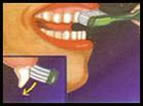 |
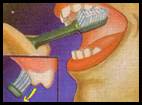 |
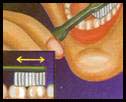 |
 |
- Brush on the outer surface, inter surface and biting surface of teeth thoroughly
- On the outer surface, tilt brush (around 45 Degrees) and brush in a gentle motion from the gum line towards the biting surface
- On the chewing surfaces, hold the brush flat and brush back and forth
- On the inside surfaces of front teeth, tilt brush and use gentle up and down strokes with the tip of the brush
- In between the teeth or interdental areas, use a small brush (interdental brush) with an in-and out sweeping motion
- Repeat brushing the surfaces until the teeth feels clean.
Is it necessary to brush your tongue as well?
Yes, because the papilla of the tongue can accumulate bacteria and food debris which may cause bad breath.
To brush your tongue, move your toothbrush from the back of your tongue to front in a sweeping motion. Repeat a couple of times until the tongue feel clean.
| Last reviewed | : | 23 August 2019 |
| Writer | : | Dr. Che Noor Aini bt. Che Omar |
| Dr. Sharol Lail Sujak | ||
| Dr. Laila bt. Abd Jalil | ||
| Reviewer | : | Dr. Sharol Lail bin Sujak |







